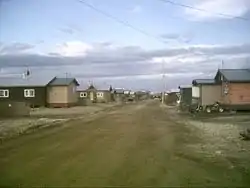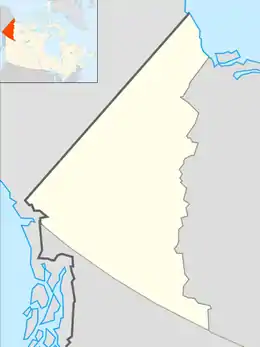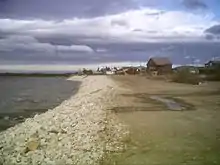Old Crow, Yukon
Old Crow (Teechik[2] in Gwich’in) is a community in the Canadian territory of Yukon. It had 221 inhabitants as of 2016, most of them Gwich'in, a First Nations people who belong to the Vuntut Gwitchin First Nation.
Old Crow
Teechik | |
|---|---|
 | |
 Old Crow  Old Crow | |
| Coordinates: 67°34′N 139°48′W | |
| Country | Canada |
| Territory | Yukon |
| Area | |
| • Land | 14.17 km2 (5.47 sq mi) |
| Population (2016)[1] | |
| • Total | 221 |
| • Density | 15.6/km2 (40/sq mi) |
| • Change 2011-2016 | |
| Time zone | UTC−07:00 (MST) |
| Canadian Postal code | Y0B 1N0 |
| Area code(s) | 867 |
| Telephone exchange | 966 |
| Website | http://www.oldcrow.ca/index.htm |
Located in a periglacial environment, the community is situated on the Porcupine River in the far northern part of the territory. Old Crow is the only Yukon community that cannot be reached by motor vehicle, requiring visitors to fly in to Old Crow Airport in order to reach it. It is a dry community.
History
A large number of apparently human modified animal bones have been discovered in the Old Crow area, notably at Bluefish Caves, about 380 km (240 mi) south, and the Old Crow Flats, located about 14 km (8.7 mi) south, that have been dated to 25,000-40,000 years ago by carbon dating, several thousand years earlier than generally accepted human habitation of North America.[3]
An Indigenous chief named Deetru` K`avihdik, literally "Crow-May-I-Walk", helped settle a community here around the 1870s and the town was named after him.[4] The village was founded around muskrat trapping, which continues to provide basic income.
The people of Old Crow are dependent on the Porcupine caribou herd for food and clothing.[5] The Porcupine caribou herd migrates to the coastal plain in the Arctic National Wildlife Refuge (ANWR) in Alaska to give birth to their young. Many citizens of Old Crow believe the herd is being seriously threatened by oil-drilling in the ANWR and have been heavily involved in lobbying to prevent it.
Transportation
Old Crow Airport provides year-round transportation to other communities. During winter time, a temporary winter road is sometimes built to transport freight into Old Crow; it is not annual, but only when a significant need arises such as a major building project.[6]
Energy supply
Electric energy is supplied by three diesel generators (170 kW, 330 kW and 600 kW), operated by ATCO Electric Yukon. As the community has no road access, diesel fuel needs to be flown in.[7]
In 2019, the microgrid was extended by a PV plant which generates electricity in the summer season, thus saving about 190.000 litres of diesel per year (~400,000 $/a). The plant has been built in an back-to-back configuration to receive a mostly continuous solar harvest during the day. Consequently, the DC capacity of the PV panels (in sum 940 kWpeak) is partly orientated westwards and partly eastwards; the AC capacity of the PV inverter is 480 kW. A battery energy storage system (BESS) has been added with an energy capacity of 350 kWh, balancing out smaller cloud fluctuations and avoiding rapid start stop cycles of the diesel gensets. The whole PV-BESS plant is $6.5 million and shall last for at least 25 years.[8][9]
Communications
Old Crow is served by Northwestel since 1971. The long distance connection originally relied on a microwave relay at Rat Pass near the Yukon/NWT border, which also provide a radio-telephone base station along the Dempster Highway, but it was frequently out of service in winter when weather conditions made helicopter access hazardous. In the late 1980s, a satellite ground station was installed in Old Crow, providing more reliable service.
The long distance connection is noteworthy for two minor incidents. In 1985, the Yukon territorial election was covered by live television coverage for the first time, sent by satellite to Toronto for switching into the network stations in Yukon; however, results from Old Crow were unavailable due to the microwave failure. On 11 September 2001, the satellite connection went out of service, and an aircraft bringing a technician to repair it was challenged by Canadian Forces aircraft for violating the closure of airspace throughout North America.
The community operated its own television transmitter to carry CBC television signals from satellite. The current status of this transmitter is unknown since the CBC in 2012 closed down analog transmitters it owned. The community has APTN television, as well as CHON-FM and CKRW transmitters and a community-owned transmitter picking up CBC station CHAK-AM in Inuvik.
Climate

Old Crow has a subarctic climate (Köppen climate classification Dfc) with mild summers and severely cold winters. Average annual temperature is −8.3 °C (17.1 °F).[10] Old Crow experiences annual temperature average daily highs of 20.2 °C (68.4 °F) in July and average daily lows of −33.5 °C (−28.3 °F) in January.[10] Record high temperature was 32.8 °C (91.0 °F) on August 30, 1976 and the lowest was −59.4 °C (−74.9 °F) on January 5, 1975.[10] Precipitation is very low, but is somewhat higher in the summer. Average annual snowfall is 141.4 cm (55.67 in) and rainfall is 154.8 mm (6.09 in).[10]
As Old Crow is located north of the Arctic Circle, it experiences polar day or midnight sun in summer and polar night in winter. The midnight sun is typically between May 5 and August 8 inclusive, while the polar night usually starts around December 14 and ends by December 29.[11]
| Climate data for Old Crow Airport, 1981–2010 normals, extremes 1951–present | |||||||||||||
|---|---|---|---|---|---|---|---|---|---|---|---|---|---|
| Month | Jan | Feb | Mar | Apr | May | Jun | Jul | Aug | Sep | Oct | Nov | Dec | Year |
| Record high °C (°F) | 2.5 (36.5) |
3.0 (37.4) |
6.7 (44.1) |
15.9 (60.6) |
28.1 (82.6) |
32.3 (90.1) |
32.4 (90.3) |
32.8 (91.0) |
23.9 (75.0) |
17.5 (63.5) |
6.1 (43.0) |
1.7 (35.1) |
32.8 (91.0) |
| Average high °C (°F) | −25.2 (−13.4) |
−21.7 (−7.1) |
−14.8 (5.4) |
−3.7 (25.3) |
8.4 (47.1) |
19.1 (66.4) |
20.2 (68.4) |
16.2 (61.2) |
7.9 (46.2) |
−5.3 (22.5) |
−19.0 (−2.2) |
−20.7 (−5.3) |
−3.2 (26.2) |
| Daily mean °C (°F) | −29.2 (−20.6) |
−26.5 (−15.7) |
−21.2 (−6.2) |
−10.1 (13.8) |
2.7 (36.9) |
12.9 (55.2) |
14.6 (58.3) |
10.9 (51.6) |
3.5 (38.3) |
−8.8 (16.2) |
−22.9 (−9.2) |
−25.1 (−13.2) |
−8.3 (17.1) |
| Average low °C (°F) | −33.5 (−28.3) |
−31.1 (−24.0) |
−27.6 (−17.7) |
−16.5 (2.3) |
−3.0 (26.6) |
6.6 (43.9) |
8.9 (48.0) |
5.4 (41.7) |
−0.9 (30.4) |
−12.2 (10.0) |
−27.1 (−16.8) |
−29.6 (−21.3) |
−13.4 (7.9) |
| Record low °C (°F) | −59.4 (−74.9) |
−54.4 (−65.9) |
−48.3 (−54.9) |
−39.5 (−39.1) |
−28.0 (−18.4) |
−8.3 (17.1) |
−2.5 (27.5) |
−9.5 (14.9) |
−22.5 (−8.5) |
−38.0 (−36.4) |
−47.0 (−52.6) |
−56.7 (−70.1) |
−59.4 (−74.9) |
| Average precipitation mm (inches) | 13.1 (0.52) |
13.8 (0.54) |
14.4 (0.57) |
9.5 (0.37) |
14.4 (0.57) |
37.2 (1.46) |
43.5 (1.71) |
46.7 (1.84) |
29.0 (1.14) |
22.1 (0.87) |
18.1 (0.71) |
16.7 (0.66) |
278.6 (10.97) |
| Average rainfall mm (inches) | 0.0 (0.0) |
0.1 (0.00) |
0.0 (0.0) |
0.7 (0.03) |
8.3 (0.33) |
34.5 (1.36) |
43.5 (1.71) |
45.8 (1.80) |
20.0 (0.79) |
2.0 (0.08) |
0.0 (0.0) |
0.0 (0.0) |
154.8 (6.09) |
| Average snowfall cm (inches) | 15.5 (6.1) |
16.4 (6.5) |
16.6 (6.5) |
9.7 (3.8) |
6.6 (2.6) |
2.8 (1.1) |
0.0 (0.0) |
1.0 (0.4) |
9.3 (3.7) |
23.0 (9.1) |
21.6 (8.5) |
18.9 (7.4) |
141.4 (55.7) |
| Average precipitation days (≥ 0.2 mm) | 9.2 | 9.6 | 9.4 | 6.6 | 6.3 | 10.8 | 13.6 | 14.4 | 12.6 | 13.6 | 11.9 | 11.4 | 129.3 |
| Average rainy days (≥ 0.2 mm) | 0.0 | 0.0 | 0.0 | 0.6 | 3.6 | 10.5 | 13.6 | 14.3 | 9.3 | 1.0 | 0.0 | 0.0 | 53.0 |
| Average snowy days (≥ 0.2 cm) | 10.0 | 9.9 | 9.5 | 6.2 | 3.1 | 0.8 | 0.0 | 0.4 | 3.9 | 13.2 | 12.6 | 11.8 | 81.5 |
| Average relative humidity (%) | 78.7 | 76.5 | 77.0 | 70.4 | 54.6 | 47.0 | 53.3 | 60.2 | 66.5 | 80.3 | 79.5 | 78.9 | 68.6 |
| Source: Environment Canada[10][12][13][14][15][16] | |||||||||||||
Population data
| Year | Pop. | ±% |
|---|---|---|
| 1991 | 256 | — |
| 1996 | 278 | +8.6% |
| 2001 | 299 | +7.6% |
| 2006 | 253 | −15.4% |
| 2011 | 245 | −3.2% |
| Canada census – Old Crow, Yukon community profile | |||
|---|---|---|---|
| 2011 | 2006 | ||
| Population: | 245 (-3.2% from 2006) | 253 (-15.4% from 2001) | |
| Land area: | 14.17 km2 (5.47 sq mi) | 14.15 km2 (5.46 sq mi) | |
| Population density: | 17.3/km2 (45/sq mi) | 17.9/km2 (46/sq mi) | |
| Median age: | N/A (M: 39.0, F: 39.5) | ||
| Total private dwellings: | 162 | 153 | |
| Median household income: | $28,244 | ||
| References: 2011[17] 2006[18] earlier[19] | |||
Notable residents
- Edith Josie, journalist
References
- "Census Profile, 2016 Census". 2016 Census. Statistics Canada.
- ANLC : Alaska Native Place Names
- Morlan, R.E. (1986), Pleistocene archaeology in Old Crow Basin: a critical reappraisal. In Bryan, A.L.,ed. New Evidence for the Pleistocene Peopling of the Americas. Orono, Maine,Center for the study of Early Man, pp.27-48.
- Old Crow History
- Fralic, Shelley (5 November 2009). "Olympic celebration and survival in Old Crow". National Post. Retrieved 4 February 2011.
- "Old Crow winter road challenges truckers". CBC News. 2014-03-03.
- "Old Crow Solar Project". Yukon University. Retrieved 2020-09-24.
- Francklyn, Lili (2018-07-11). "Bringing A Renewable Microgrid to the Canadian Arctic Village of Old Crow". HOMER Microgrid News. HOMER Energy. Retrieved 2020-09-24.
- "Old Crow Solar Project" (PDF). bba.ca. Breton, Banville and Associates. 2019-04-18. Retrieved 2020-09-24.
- "Old Crow A". Canadian Climate Normals 1981–2010. Environment Canada. Climate ID: 2100800. Retrieved 25 July 2016.
- Sunrise Sunset Old Crow 2012
- "Old Crow RCS". Canadian Climate Data. Environment Canada. Climate ID: 2100805. Retrieved 25 July 2016.
- "Daily Data Report for April 2009". Canadian Climate Data. Environment Canada. Climate ID: 2100805. Retrieved 25 July 2016.
- "Daily Data Report for May 2010". Canadian Climate Data. Environment Canada. Climate ID: 2100805. Retrieved 25 July 2016.
- "Daily Data Report for June 2004". Canadian Climate Data. Environment Canada. Climate ID: 2100805. Retrieved 25 July 2016.
- "Daily Data Report for July 1998". Canadian Climate Data. Environment Canada. Climate ID: 2100805. Retrieved 25 July 2016.
- "2011 Community Profiles". 2011 Canadian Census. Statistics Canada. July 5, 2013. Retrieved 2012-05-14.
- "2006 Community Profiles". 2006 Canadian Census. Statistics Canada. March 30, 2011. Retrieved 2009-02-24.
- "2001 Community Profiles". 2001 Canadian Census. Statistics Canada. February 17, 2012.
Further reading
- Josie, Edith. Old Crow News: The Best of Edith Josie, 1964. Whitehorse, Yukon: Whitehorse Star, 1964.
- McSkimming, Robert James. Territory, Territoriality and Cultural Change in an Indigenous Society: Old Crow, Yukon Territory. [S.l: s.n.], 1975.
External links
| Wikimedia Commons has media related to Old Crow, Yukon. |